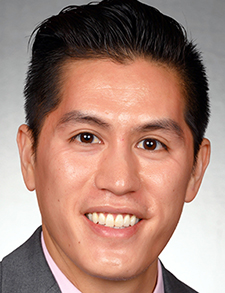 With transgender care under debate among politicians and state laws around the U.S., hospitalists find they must take a leading role in making transgender patients feel welcome and helping them receive equitable care.
With transgender care under debate among politicians and state laws around the U.S., hospitalists find they must take a leading role in making transgender patients feel welcome and helping them receive equitable care.
At the same time, survey results presented at SHM Converge in 2021 found that 51% of 259 respondents did not feel clinically competent in providing care to transgender patients and 78% wanted to learn more about LGBTQIA+ healthcare.1
The 2022 U.S. Transgender survey from the National Center for Transgender Equality, which included more than 92,000 transgender people, found that among those who had seen a healthcare practitioner in the previous 12 months, 48% had at least one negative experience because they were transgender. This included being refused healthcare, being misgendered, having a clinician use harsh language with them, or having a practitioner be physically rough or abusive when treating them.2
Among those with health insurance in the survey, 26% had at least one issue with their insurance company in the previous year, such as being denied coverage for hormone therapy, surgery, or another type of healthcare issue linked to their gender identity or transition.2
Challenges for equitable care
Oklahoma, South Carolina, Missouri, and Tennessee are the four states with the largest number of anti-trans bills under consideration this year, according to the website Trans Legislation Tracker. In Oklahoma alone, 60 anti-trans bills had been introduced as of mid-April.3
The number of anti-trans bills across the U.S. has increased rapidly since 2021; in that year, 143 bills were introduced and 18 passed. By 2023, 600 bills were introduced around the U.S., and 87 passed. Pertinent legislation around the U.S. relates to topics such as diversity, equity, and inclusion (DEI); trans individuals participating in sports; teaching about LGBTQIA+ youth; and other topics.

Dr. Bishop
Laura Bishop, MD (she/her), an associate professor in internal medicine and pediatrics and the med-peds associate program director at the University of Louisville in Kentucky, has observed that out of fear, some patients have been less inclined to disclose their gender identities to treatment teams or their families. Among young patients, changes to gender-affirming care in Kentucky have led to an abrupt discontinuation of hormones. This also has led to an increase in mental health crises among patients who are already impacted by financial insecurities and are not typically able to travel to other states for care.
This fear trickles down to other members of the LGBTQIA+ community.
The anti-trans legislative climate in many states creates a catch-22, says Anthony Dao, MD (he/him), an assistant professor of medicine at Washington University School of Medicine in St. Louis, Mo., and director of OUTmed, a group for LGBTQIA+ trainees, faculty, and staff at WashUMed. Anti-trans or anti-LGBTQIA+ legislation may lead people in these population groups to move elsewhere. At the same time, this lessens overall diversity, perhaps continuing to limit views from others.

Dr. Dao
“I don’t know a single queer person who hasn’t thought about leaving Missouri,” said Dr. Dao, who is gay. “Part of my decision to stay was knowing that I’ve committed to creating a difference for my community. Things won’t be better in Missouri if I leave. Each person in our community matters.” Restrictions to the practice of evidence-based medicine have repercussions that go further than intended, says Dr. Bishop, a point that she has shared in recent talks with legislators. “When pediatric endocrinologists are less inclined to train in a state that restricts their full practice, it affects many more patients than those who are transgender,” she said.

Dr. Khanijow
Although many hospitalists may want to learn more about transgender care, there’s also a lack of sufficient education. This can turn into “transgender broken arm syndrome,” said Keshav Khanijow, MD (he/him), who’s an assistant professor at the Johns Hopkins University School of Medicine in Baltimore, and chair of the SHM Diversity, Equity, Inclusion, and Justice Special Interest Group. “One pitfall for clinicians is becoming overwhelmed and hyper-concentrated on a patient’s transgender identity because of their presenting concern and misattributing causes of their hospitalization to gender-affirming hormones as opposed to other reasons,” he said.
Another pitfall Dr. Khanijow has seen is the use of the wrong terms when referring to trans patients, such as “transsexual,” “gender reassignment” surgery or hormones, and “a transgender,” which can be offensive.
“Unfortunately, ICD-10 codes may not have caught up to this and still use some of this offensive terminology in coding,” said Dr. Khanijow, who is also a member of the SHM Diversity, Equity, and Inclusion Committee.
Appropriate terminology would be what the patient states their gender identity is, though commonly “the patient is a trans woman” (or man) is okay, Dr. Dao says. Another example is “The patient identifies as a non-binary individual and uses they/them pronouns.”

Dr. Wright
Similarly, electronic health records (EHRs) may not have caught up with appropriate terminology and may not have a clear, consistent way to collect pronouns. This means that trans patients may be asked repeatedly for their pronouns, Dr. Dao says.
Deficiencies in education about transgender health basics are common among even well-meaning practitioners, particularly those who graduated before 2015, says Masina Wright, MD (they/themme), a locum hospitalist in New Mexico. “Let’s take perioperative medicine, for example,” they said. “For those practicing hospital medicine, have you ever taken a CME course on perioperative management of a transgender woman on gender-affirming hormones? What does the evidence say? Is this discussed in Grand Rounds at your hospital?”
Improving transgender care at the administrative level
Although equitable care for transgender patients faces obstacles, there are still initiatives that hospitalists can take to improve care. Here are some strategies to implement at the administrative level.
Aim for a diverse clinical team. “Administrators are high-level people who care about various perspectives and care for different patients. They should be thoughtful in curating their team to have various opinions and diversity,” Dr. Dao said. Having various perspectives increases the chance that someone on the team will be thinking about building trust with different groups of people, including transgender patients.
Advocate for more education about transgender care and LGBTQIA+ care in general. This education can take place at the hospital level (including asking about pronouns) as well as at conferences. SHM has modules on its learning portal that are updated with appropriate documentation and recommended language, and it released a module on transgender healthcare in 2021, Dr. Khanijow says. On a more global level, the World Professional Association for Transgender Health will take place this September in Portugal, Dr. Wright says. There’s also a U.S. Professional Association for Transgender Health every other year, with the last one held in 2023. However, Dr. Wright would like to see trans health integrated into a variety of conferences so it becomes normalized. “Once the appropriate language and basic foundational understanding of gender diversity become just a regular part of the human experience, trans folks can be seen like every other human in the medical system—depoliticized,” they said.
Use EHRs that allow staff to easily list pronouns and remind staff to list those pronouns. “An EHR that easily identifies pronouns/names and actually prints them to a daily list can prevent damaging misgendering or dead-naming,” Dr. Bishop said. Dead-naming is the use of a name given to someone at birth that they no longer use due to a gender transition.
Participate in DEI committees. This can assist with better care for transgender as well as all other patients. “Hospitalists should collaborate with members of their DEI committees,” Dr. Dao said. “Many DEI committees feel like the ‘minorities’ are there to teach the majority. The truth is that all hospitalists are responsible for the advancement of all people.”
Be a leader and set the tone. “In hospital medicine, a lot of the care is driven by the hospitalist,” Dr. Dao said. “You really set the tone for your team when you’re there. When you have a trans patient, as the leader of the time, you’re setting that positive tone for the patient and making sure [fellow staff] know that the patient is trans and has preferred pronouns.” He also reminds staff of the importance of not misgendering the patient or unnecessarily exposing them. If they have questions about the patient, they can ask a team member or review the chart rather than asking the patient. “Creating a safe environment for your staff to ask you questions has allowed me to have meaningful conversations with my nurses and staff, especially because most intent is that of curiosity rather than of harm,” he said. “Sometimes, it may involve focusing on what everyone can do to best help the patient move forward with their chief health concern.”
Improving transgender care at the patient level
There are also specific approaches and strategies that hospitalists can take directly with transgender patients to improve their care:
 Question what biases you might have. “One has to look inward and see if they have any implicit or explicit biases to transgender and gender-diverse individuals,” Dr. Khanijow said. “Are there stereotypes or thoughts that one has about transgender and gender-diverse people? If so, what are those thoughts? Being able to identify these biases is the first step in actively working against them when providing patient care.”
Question what biases you might have. “One has to look inward and see if they have any implicit or explicit biases to transgender and gender-diverse individuals,” Dr. Khanijow said. “Are there stereotypes or thoughts that one has about transgender and gender-diverse people? If so, what are those thoughts? Being able to identify these biases is the first step in actively working against them when providing patient care.”
Focus on their chief health concern. Avoid “transgender broken arm syndrome,” Dr. Khanijow cautions.
Aim for equitable care, not just equal care, Dr. Khanijow advises. Because of the prejudice faced by transgender patients, this may mean taking extra steps to keep these patients safe and comfortable, such as receiving a private room or a room with someone of the same gender identity and setting up reasonable post-discharge follow-up with clinics known for culturally competent care. This also can mean supporting the patient’s identity while they are at the hospital with the use of makeup, prostheses, clothing, or jewelry of their choice. Although hospitalists are bound by local laws, they still can empathize with the patient about how unfair a legal situation might be and try to come up with creative solutions to help patients achieve their goals despite a hostile legal environment, Dr. Khanijow says.
Acknowledge their partners. It’s typical for providers to ask patients if they have a partner to be inclusive, but also be aware that patients may sometimes refer to their partners as their “friends,” Dr. Dao said. “While it’s unnecessary to bully your patient into telling you who is actually with them, it’s important to take a moment and thank them for being there for the patient,” he said. This also includes asking partners what their pronouns are or asking the patient if they can share their partner’s pronouns.
Encourage the use of gender-affirming hormones, PrEP, or other related medications unless there’s a clear contraindication, Dr. Dao says. This is yet another area that’s ripe for more education geared toward hospitalists and other providers. In the 2022 U.S. Transgender Survey, 98% of respondents receiving hormone treatment reported that hormones for their gender identity or transition made them a lot more satisfied (84%) or a little more satisfied (14%) with their life.
Vanessa Caceres is a medical writer in Bradenton, Fla.
References
- Khanijow K, Rosendale N, et al. Quantifying Hospitalist Education and Awareness of LGBTQ Topics in Health: The Q-Health Project: Abstract 40 published at SHM Converge 2021. Society of Hospital Medicine website. https://shmabstracts.org/abstract/quantifying-hospitalist-education-and-awareness-of-lgbtq-topics-in-health-the-q-health-project/. Accessed April 23, 2024.
- James SE, Herman JL, et al. Early Insights: A Report of the 2022 Transgender Survey. Washington, DC: National Center for Transgender Equality; 2024. Available at: https://transequality.org/sites/default/files/2024-02/2022%20USTS%20Early%20Insights%20Report_FINAL.pdf. Accessed April 23, 2024.
- Oklahoma. Trans Legislation Tracker website. https://translegislation.com/bills/2024/OK. Accessed April 23, 2024.